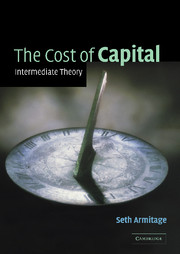Book contents
- Frontmatter
- Contents
- List of figures
- List of tables
- Preface
- Part I Expected Returns on Financial Assets
- Part II A Project's Cost of Capital
- 6 Project valuation
- 7 Corporation tax, leverage and the weighted average cost of capital
- 8 Personal tax and the cost of equity: the old and the new views
- 9 Personal tax, leverage and multiple tax rates
- 10 Inflation and risk premiums
- 11 The international dimension
- Part III Estimating the Cost of Capital
- References
- Index
11 - The international dimension
Published online by Cambridge University Press: 05 June 2012
- Frontmatter
- Contents
- List of figures
- List of tables
- Preface
- Part I Expected Returns on Financial Assets
- Part II A Project's Cost of Capital
- 6 Project valuation
- 7 Corporation tax, leverage and the weighted average cost of capital
- 8 Personal tax and the cost of equity: the old and the new views
- 9 Personal tax, leverage and multiple tax rates
- 10 Inflation and risk premiums
- 11 The international dimension
- Part III Estimating the Cost of Capital
- References
- Index
Summary
We have so far assumed implicitly that investors invest and companies operate entirely within a single country. We now consider some of the implications of the existence of more than one country. The chapter is concerned with two issues in particular: a project's cost of equity if more than one country exists, and the valuation of a foreign project – i.e. a project that is owned by a company with a head office in a different country.
The cost of equity
An integrated world capital market, and PPP holds
The cost of equity has been analysed in an international context under a variety of assumptions. One assumption that could be made is that there is an integrated world capital market. This means that there is no difference between domestic and foreign assets, for example in terms of transactions costs, tax treatment or the availability of information. The investment opportunity set is the same for all investors. A domestic asset can be defined as one that, from the perspective of a resident of the country concerned, is traded on a local financial market and has been issued by a local company or other body (e.g. the government). A local company is one with its head office in the country. An integrated market does not require the existence of a single worldwide currency, although concern about currency risk is no doubt one of the factors that, in practice, causes markets to be somewhat segmented.
- Type
- Chapter
- Information
- The Cost of CapitalIntermediate Theory, pp. 236 - 258Publisher: Cambridge University PressPrint publication year: 2005



